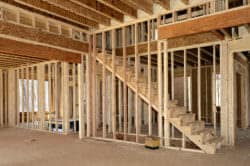Load Bearing Walls: Removal Issues & Warning Signs
Home » Structural »

Removing a load bearing wall may create structural problems in a home, including sagging ceilings, unleveled floors, drywall cracks, and sticking doors. Recognizing the warning signs of this is important. Even removing just a portion of a load bearing wall to create a wider door or window opening can be a problem if not done correctly.
Removal of load bearing walls without properly supporting the load they’re carrying may occasionally result in a structural collapse and even injury.
What is a load bearing wall?
A home has two basic types of walls, load bearing and non-load bearing. Just as the name implies, one carries weight above it and the other does not. A load bearing wall is a structural wall that may carry the weight of the roof, the weight of upper floors, and even the weight of a room’s ceiling. The weight is often referred to as the “load”.
The load, starting with the roof and everything under the roof gets transferred down to the footings. Engineers will often refer to the “load path”, which is basically the way or route that the weight gets transferred down to the home’s foundation and/or piers.
Generally, the outside walls are load bearing. The interior walls of a home may or may not be load bearing, depending on how the house was engineered. In older homes with a hallway down the center, one or both of the hallway walls may be load bearing. In many newer one-story homes that are built with trusses, there may not be any interior load bearing walls because all of the loads get transferred to the exterior walls by the trusses.
Remodeling

The most likely time that a load bearing wall gets removed is when a home has remodeling work done. Owners of older homes often want to have a more open floor plan, so they remove walls to get a more open look. In the process, they remove a load bearing wall and don’t realize that it is a load bearing wall. Professional contractors will normally check first to see if a wall is load bearing before they remove it. If it is, they will usually put a header (wood or steel) in the opening to carry the weight. At times an engineer may have to do calculations on the design and header size.
Warning signs that a load bearing wall has been removed
Ceiling sagging or dropped down
If a wall is removed between two rooms or even moved to enlarge a room, then the ceiling may sag. This happens when proper structural support was not installed to carry the weight that the removed wall was holding. Drywall and plaster ceilings are generally connected to wooden ceiling joists spaced at 12, 16 or 24 inches on center or connected to wooden trusses. When a wall is removed that holds up the ends of the ceiling joists or the trusses, then the weight of the ceiling and any load above it may cause the ceiling to sag or drop down. The ceiling may sag a half-inch or more, and in a few instances may collapse.
A 1/4 inch sag or a 2-inch sag?
Ceilings that sag a quarter or even a half of an inch are not always a sign that a load bearing wall has been removed, since over time ceilings may sag naturally. If a ceiling drops a half-inch right after a load bearing wall has been removed, then that is a concern. A ceiling that sags an inch or two becomes more of concern that a load bearing wall has been removed and that the ceiling has not been properly supported. Consulting with a structural engineer can provide valuable information.
Floor sagging or not level
If a two or three-story home has a load bearing wall removed without providing proper structural support, then the second or third story floor may sag in the area above where the load bearing wall under the floor was removed. If you see the floor on the second or third story sags, then you should go down one story and look at the ceiling area for sags or bows.
Doors and windows rubbing or sticking
If a load bearing wall has been removed on the first floor without proper support installed for the load above it; then the doors or windows on the floor above it may rub, stick, or not open because of the framing in the wall that the door or window is in may have shifted.
Remember that there are a number of reasons that doors or windows may stick or rub other than a load bearing wall being removed. These reasons may include the shifting or movement of the foundation, swelling due to humidity and moisture, too many coats of paint, or even poor workmanship and installation.
Cracks in the drywall or plaster
It is common for cracks to appear in the drywall or plaster when a load bearing wall is removed without properly supporting the load that it was carrying. This is basically because the ceiling area may drop or sag, resulting in cracks. Cracks may also occur in some of the wall areas due to the stress generated by the movement of the framing, ceilings, and walls.
Note: Warning signs that a load bearing wall has been removed and no proper support has been installed, may not show up immediately after the work is done. It may take months or even years for the warning signs of problems to show.
Removing a load bearing wall

When a load bearing wall is removed, or even a portion of it, there should be a plan on how the weight that it is carrying will be supported. The removal of a load bearing wall should be done by a professional who understands how the weight that it is carrying will be temporarily supported while the permanent support modifications are being installed. If the area being removed is small and the load is not excessive there may not need to be support or just minimal support may be needed.
Typically a beam, either wood or metal, will be installed in the area where the wall was removed to carry the weight. At times a contractor may refer to this beam as a “header”.
At each end of the header or beam, a contractor will usually have a support of some type, often a post. The base of this post needs a solid area or base to sit on. At times a concrete pier or footing is required to be installed to facilitate carrying the weight.
Engineers have different ways to support a ceiling where a load bearing wall has been removed
Homeowners and buyers usually have several choices on how to support the load above a load bearing wall once removed. Naturally, some ways are more complex or costly than others. Knowledgeable and appropriately qualified general contractors and framing contractors are good resources to consult with as well as structural engineers.
Permits
Generally, most Building Jurisdictions require a permit when there are structural modifications to a house. Small openings for doors and windows are typically quick and easy to obtain. When a long or large load bearing wall is going to be removed, then the building departments will usually require a set of plans that are stamped by a structural engineer. If there is any electrical or plumbing in the wall, then an electrical and plumbing permit may be required for those modifications.

- You may only need preventive maintenance
- If very minor, then maybe you just need to monitor it
- If repair is needed, it is much cheaper to correct in the early stages than after it has become a big problem
- Should it be major, then you may need to consult a qualified professional
Take a minute and review our other articles to see if you have any warning signs of potential issues.
Articles and Resources On Common Structural Issues In Homes










Hi we took down a load bearing wall almost 9 years ago. The contractor put a header in. Working the first year wer noticed the floor upstairs seemed to settle around it. There is a slight “bump” in the hardwood floor. Now there are no cracks in the ceiling, but we are noticing a line on the ceiling where the header is. Should we be concerned?
How difficult/costly it is to remove 3 out of 4 outside load bearing walls in order to extend on 3 of the 4 sides of a one storey house only ( ground plus floor above)?
So the load bearing walls will be removed immediately below the roof.
Great post! Load-bearing walls are essential to the structural integrity of a building, and their removal can result in significant damage or collapse. Before removing a load-bearing wall, it is important to consult with a licensed structural engineer to determine its significance and identify any necessary supports or reinforcements. Warning signs of a load-bearing wall issue include sagging floors or ceilings, cracks in the walls, doors or windows that do not close properly, and sloping or uneven floors. It is crucial to address these issues promptly and to avoid attempting any DIY solutions without proper knowledge and experience. By taking the necessary precautions, you can ensure the safety and stability of your home or building.